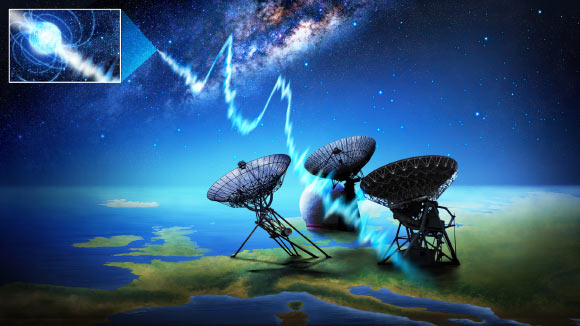Astronomers have detected two more millisecond-duration radio bursts from SGR 1935+2154, a magnetar located over 14,000 light-years away in the constellation of Vulpecula. The detection supports the hypothesis that — at least some — fast radio bursts are emitted by magnetars at cosmological distances.
Source: Sci News
Fast radio bursts (FRBs) are mysterious and rarely detected bursts of radio waves from space.
These events have durations of milliseconds and exhibit the characteristic dispersion sweep of radio pulsars.
They emit as much energy in one millisecond as the Sun emits in 10,000 years, but the physical phenomenon that causes them is unknown.
One theory hypothesized FRBs to be neutron stars with exceptionally strong magnetic fields, commonly known as magnetars.
On April 28, 2020, a breakthrough was made when two teams of astronomers independently detected an extremely bright radio burst from the Galactic magnetar SGR 1935+2154, using the Canadian Hydrogen Intensity Mapping Experiment Fast Radio Burst Project (CHIME/FRB) and the Survey for Transient Astronomical Radio Emission 2 (STARE2), respectively.
The specific energy of the burst, dubbed FRB 200428, was similar to, although approximately 30 times less than, the specific energy of the faintest known FRB.
In May 2020, a research team led by Chalmers University of Technology astronomer Franz Kirsten pointed four radio telescopes towards SGR 1935+2154.
“We didn’t know what to expect,” said team member Dr. Mark Snelders, an astronomer in the Anton Pannekoek Institute for Astronomy at the University of Amsterdam.
“Our radio telescopes had only rarely been able to see fast radio bursts, and this source seemed to be doing something completely new. We were hoping to be surprised!”
The astronomers monitored SGR 1935+2154 every night for more than four weeks after the discovery of FRB 200428, a total of 522 hours of observation.
On May 24, they detected two bright radio bursts with fluences of 112 ms and 24 ms, respectively, but separated in time by 1.4 s.
“We clearly saw two bursts, extremely close in time,” said team member Dr. Kenzie Nimmo, astronomer in the Anton Pannekoek Institute for Astronomy and ASTRON.
“Like the flash seen from the same source on April 28, this looked just like the fast radio bursts we’d been seeing from the distant Universe, only dimmer. The two bursts we detected on May 24 were even fainter than that.”
Together with the FRB 200428 burst, as well as a much fainter burst seen by the FAST radio telescope, the new observations demonstrate that SGR 1935+2154 can produce bursts with apparent energies spanning roughly seven orders of magnitude, and that the burst rate is comparable across this range.
“The brightest flashes from this magnetar are at least 10 million times as bright as the faintest ones,” said team member Dr. Jason Hessels, an astronomer in the Anton Pannekoek Institute for Astronomy and ASTRON.
“We asked ourselves, could that also be true for fast radio burst sources outside our Galaxy?”
“If so, then the Universe’s magnetars are creating beams of radio waves that could be criss-crossing the cosmos all the time — and many of these could be within the reach of modest-sized telescopes like ours.”
The findings were published in the journal Nature Astronomy.
Source: Sci News

































Leave a Comment
You must be logged in to post a comment.